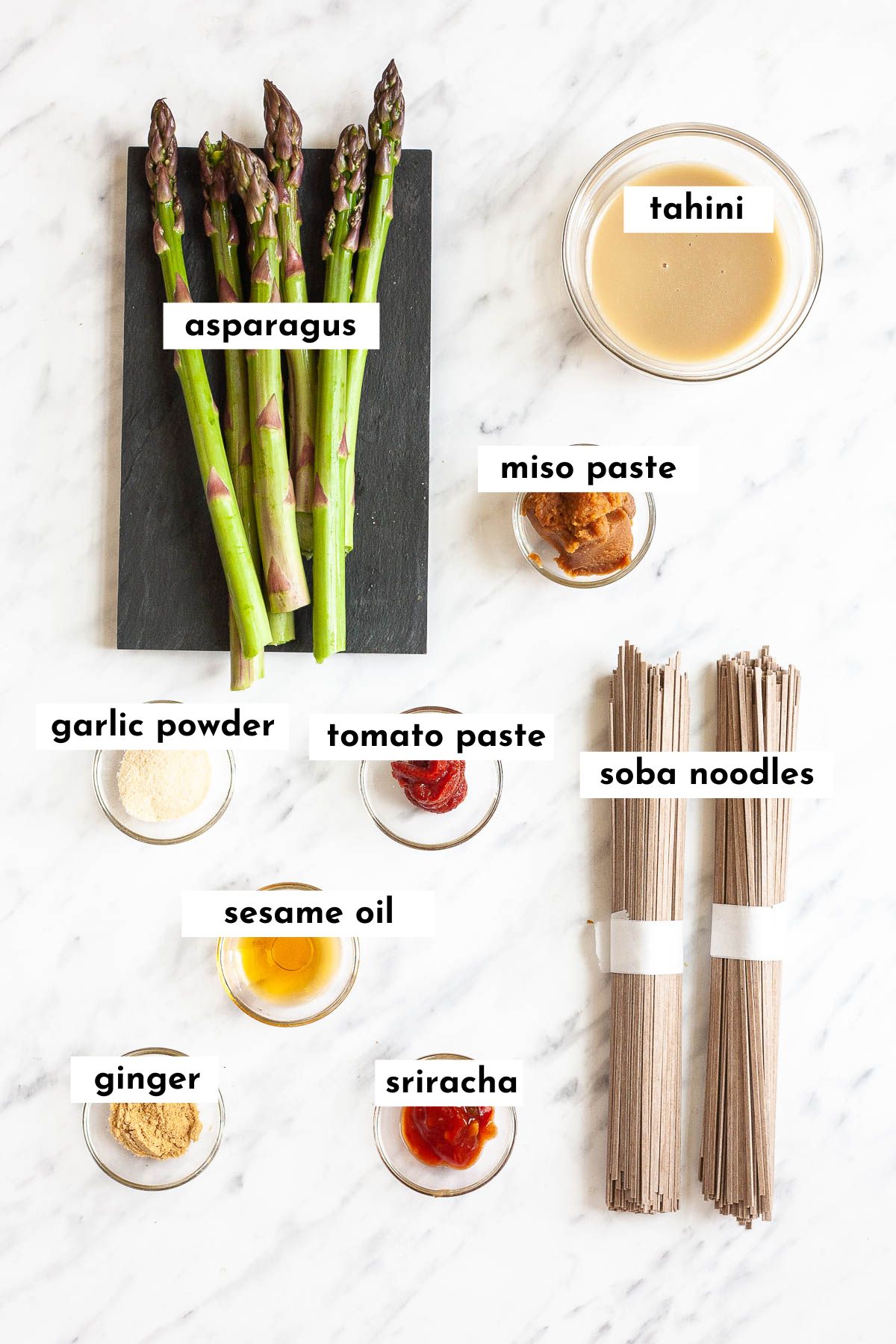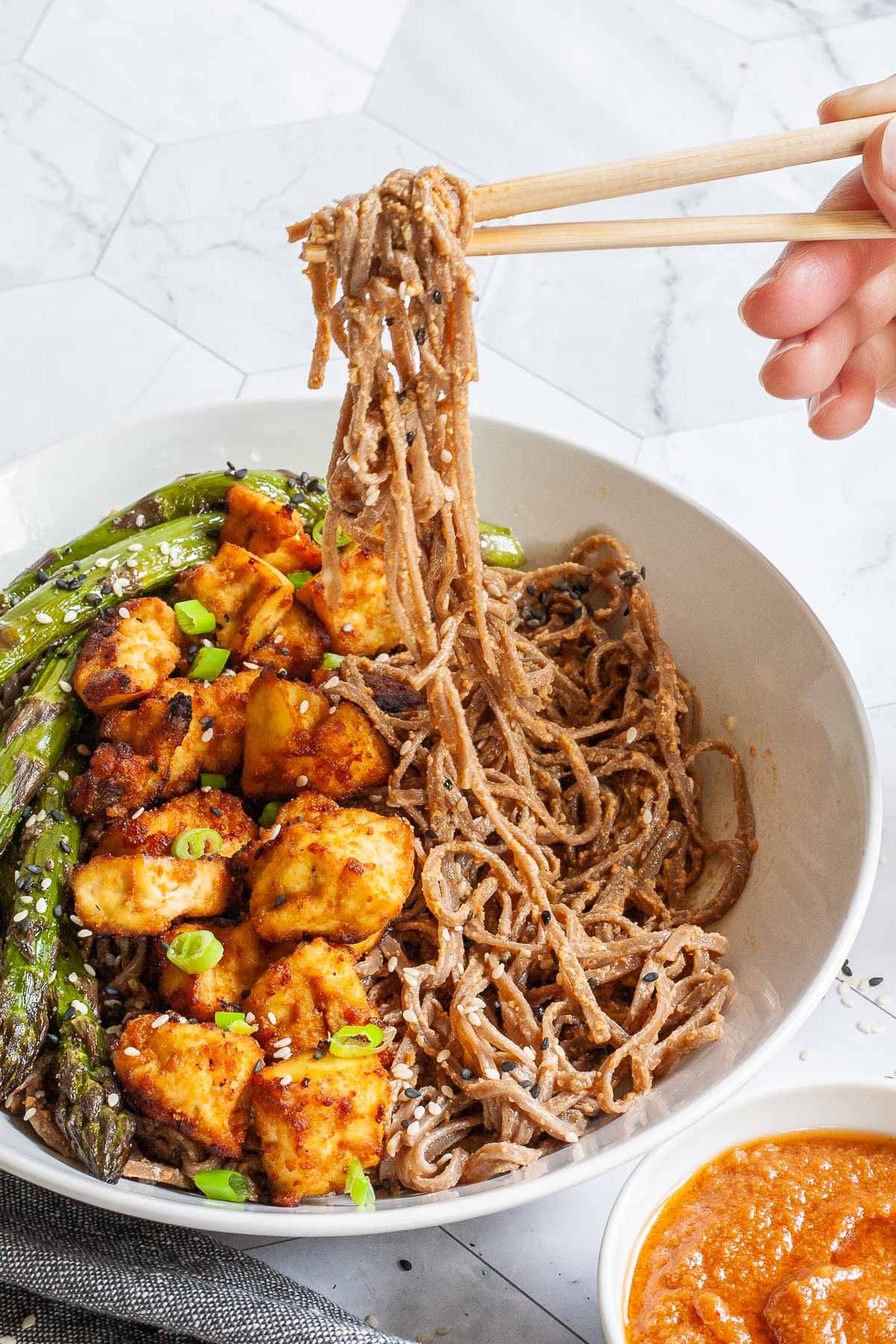If you are looking for the most delicious miso noodles recipe, this spicy tahini miso sauce will surely deliver. It is not only delicious, but it is also an easy, no-cook sauce that you can mix within 5 minutes. Soba noodles are the perfect candidate to elevate these flavors. They are served with crispy miso tofu bites and roasted asparagus. Isn’t it just beautiful?

Want to save this post?
Enter your email below and get it sent straight to your inbox. Plus, I’ll send you budget recipes and money-saving tips every week!
If you like Asian-inspired noodle recipes, try our Thai oyster mushroom noodle stir fry, this Thai glass noodles stir fry (pad woon sen), or this cold Thai glass noodle salad (yum woon sen) recipe. Not to mention we love adding noodles to our Vietnamese spring rolls as well.
What to expect from this recipe?
Let me start by saying what is so special about soba noodles. The best part is its texture. While rice noodles can appear to be soft, or even slimy, soba noodles resemble more like wheat noodles. They have this bouncy, firm, and chewy texture that you would expect from egg noodles.
Soba noodles are usually 100% made of buckwheat flour, but sometimes rice or wheat flour is added. Be sure to read more about which noodles are gluten-free to choose the right one for you.
Baked goods that are using buckwheat flour can be bitter, and nutty. I can definitely taste it and I get that not all people are fancy about it. However, we usually use this soba noodle brand where the buckwheat taste is quite mild since it is combined with brown rice. It is perfect for this recipe.
Tahini is toasted ground sesame seeds. You may have heard of it as one of the essential ingredients in hummus (or not) as well as widely used by people who need to eat nut-free. It is a distinctive nutty flavor if you use it too much. However, in combination with the right ingredients, you may only have a hint of taste, but you end up with a lovely creamy texture.
Miso paste is a widely used Japanese ingredient, which is actually fermented soybeans basically. (Please note that not all miso pastes are gluten-free, so check the packaging for certified products!) There are 3 types: white (shiromiso), red (akamiso), and mixed (awasemiso).
It is savory and quite salty. I can taste that is made of soybean. And the fact that it is fermented miso paste recipes usually tastes tangy too. It is best if combined with strong spices and seasoning as it will deepen their flavor. It is similar to soy sauce but milder and not as potent.
What can you expect if you make these tahini miso soba noodles?
- a creamy, and rich sauce
- mildly spicy, but definitely savory
- elastic, chewy noodles
- quick, no-cook sauce

Ingredients
To make this miso noodles recipe you will need 9 ingredients only. You can mix and match the add-ins and toppings depending on your taste. We added our crispy miso tofu bites and roasted asparagus, but we will give you even more ideas down below.

- Soba noodles – We use this soba noodle brand which contains buckwheat and brown rice as well.
- Miso paste – We use this gluten-free white miso that contains soybeans, rice, water, salt, and alcohol only.
- Tahini – There is a slight difference in taste among the different tahini brands. Our favorite is this brand* since it has no bitter after-taste.
- Soy sauce – Choose a gluten-free alternative like tamari, since soy sauce is not compliant with a gluten-free diet.
- Garlic powder
- Ginger powder
- Sesame oil – All Asian-inspired recipes are better with sesame oil than with regular sunflower oil.
- Spicy chili paste – We used sriracha in this recipe, but you can use any of your favorites from around the world may it be sambal oelek, peri peri, gochujang, or harissa.
- Tomato paste – I call it a flavor enhancer. It makes the noodle sauce richer.
🛒 You can find detailed measurements for all ingredients in the printable version of the recipe card at the bottom of this post.
Instructions
So how to make spicy miso soba noodles with tahini? It is laughingly simple really. So much so that it became a usual addition to our weekly rotation since you can make it in 10 minutes without toppings. It is even shorter than making our vegan alfredo sauce since you need 15 minutes to do that. This tahini miso sauce for noodles is the new record-holder.
- Boil water in a kettle.
- Take a stockpot or a large pan and add boiled water. Continue boiling it and add soba noodles as well as a bit of salt.
- Cook soba noodles according to packaging instructions. Drain when they are tender and soft. (Think of more towards al dente than over-cooked mushy.)
- Take a mixing bowl and add all sauce ingredients: miso paste, tahini, tamari, garlic powder, ginger powder, sriracha, tomato paste, and sesame oil. Mix well with a spoon or spatula. See the below photo to check the consistency.
- Serve soba noodles in bowls and add a couple of tablespoons of the sauce on top. Mix well with a fork. Add any optional garnish and topping and enjoy.
- You can serve these spicy miso noodles cold or stir fry them quickly to warm all ingredients up. They taste delicious either way.

What to serve with it?
If we are opting for something quick and easy, we love serving this miso noodles recipe with green vegetables. It is perfect with quick pan-wilted spinach, roasted asparagus, or grilled bok choy.
If you were to add some extra protein, we cannot recommend enough our crispy spicy miso tofu bites (below photo) which we especially made for this miso recipe.

If you need even more ideas, here are some of our suggestions:
- Lightly roasted cherry tomatoes or sun-dried tomatoes
- Red peppers or if you love it fiery, add some more red pepper flakes
- Pan-fried oyster mushrooms
- Other mushrooms like portobello or shiitake
- Sauteed broccoli or even better broccolini
- Green peas or snap peas (mangetout)
- Sweet corn
- Legumes (beans, lentils) like white/cannellini beans, red kidney beans, chickpeas (roasted or cooked)

FAQs and substitutions
Which noodles to choose?
You can use other types of noodles as well like egg noodles, udon noodles, or rice noodles. However, if you need to eat gluten-free, we recommend reading our “are noodles gluten-free” article, where we go through all types and offer recommendations for certified gluten-free products.
What can you use instead of tahini?
We have a whole post about all the tahini substitutes you can use since there are some people who either find it expensive or just don’t like its flavor. The closest substitute is sunbutter or other types of nut butter.
What can you use instead of miso paste?
The best substitute would be soy sauce (or any of these soy sauce substitutes). But since miso paste is creamy, while soy sauce is quite thin the consistency of the sauce will be off. However, since soy sauce has a stronger flavor adding more tahini to give the sauce creaminess will be complemented.
How to store it?
If you have any leftovers you can keep them in the fridge for 1-2 days. A quick note though that the longer you store it, the more sauce the noodles will absorb. It means that on day 2, your noodles might be much drier.

Allergen info
This Tahini Miso Soba Noodles recipe is meat-free, dairy-free, and egg-free.
- Vegan – All ingredients are supposed to be vegan. I haven’t really seen soba noodles with eggs, but just in case be on the lookout and read the ingredient list before purchasing any product.
- Nut-free – As far as I know, none of the ingredients should include any nuts. Tahini is made of sesame seeds, so that should be all right. To be on the safe side, check for cross-contamination issues in any products you buy including miso paste, tahini, soy sauce, and chili paste.
- WFPB-friendly (whole foods plant-based) – This miso soba noodles recipe will only be compliant if you skip sesame oil. The consistency of the sauce will be different, but the taste will not be that much off. Sesame oil gives a bit of extra nutty flavor but you can add a tiny bit more from tahini and it should be perfect. None of the other ingredients should contain oil.
- Gluten-free – Soy sauce is not gluten-free, so use substitutes like tamari or liquid aminos. All other ingredients are supposed to be gluten-free, but always check the packaging for cross-contamination info. Especially soba noodles as some brands add wheat flour for more elasticity.
- Soy-free – It is a recipe with miso that is made of fermented soybeans so sadly it is indeed not soy-free. Maybe try our harissa tahini pasta sauce recipe instead which contains no soy-based ingredients.
More vegan noodles recipes
THANK YOU so much for visiting our website. Please comment below if you have tried this recipe. We LOVE hearing from you! If you loved the recipe, please don’t forget to give us a ⭐⭐⭐⭐⭐ RATING. We appreciate all of our readers.

⇒ GET OUR FREE 7-DAY VEGAN MEAL PLAN E-BOOK NOW! OR CHECK OUT ALL VEGAN MEAL PLAN RECIPES! ⇐

Spicy Tahini Miso Soba Noodles
Ingredients
- 5 oz Soba noodles
- 1 Tbsp Miso paste
- 4 Tbsp Tahini
- 1 tsp Sriracha (or any other chili paste)
- 1 tsp Garlic powder
- ½ tsp Ginger powder
- 2 tsp Sesame oil
- 1 tsp Tomato paste
- 1 Tbsp Soy sauce or tamari
Add-ins
Instructions
- Boil water in a kettle.
- Take a stockpot or a large pan and add boiled water. Continue boiling it and add soba noodles as well as a bit of salt.
- Cook soba noodles according to packaging instructions. Drain when they are tender and soft. (Think of more towards al dente than over-cooked mushy.)
- Take a mixing bowl and add all sauce ingredients: miso paste, tahini, soy sauce, garlic powder, ginger powder, sriracha, tomato paste, and sesame oil. Mix well with a spoon or spatula.
- Serve soba noodles in bowls and add a couple of tablespoons of the sauce on top. Mix well with a fork. Add any optional garnish or topping and enjoy.
- You can serve these spicy miso noodles cold or stir fry them quickly to warm all ingredients up. They taste delicious either way.










Leave a comment